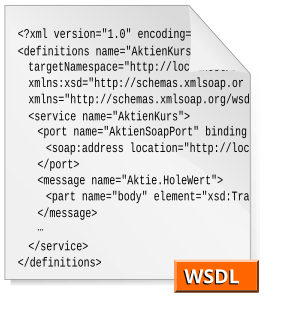
Hypertext Markup Language (HTML) is the standard markup language for documents designed to be displayed in a web browser. It can be assisted by technologies such as Cascading Style Sheets (CSS) and scripting languages such as JavaScript.
The term Web service (WS) is either:

Outlook Express, formerly known as Microsoft Internet Mail and News, is a discontinued email and news client included with Internet Explorer versions 3.0 through to 6.0. As such, it was bundled with several versions of Microsoft Windows, from Windows 98 to Windows Server 2003, and was available for Windows 3.x, Windows NT 3.51, Windows 95, Mac System 7, Mac OS 8, and Mac OS 9. In Windows Vista, Outlook Express was superseded by Windows Mail.
The WS-I Basic Profile, a specification from the Web Services Interoperability industry consortium (WS-I), provides interoperability guidance for core Web Services specifications such as SOAP, WSDL, and UDDI. The profile uses Web Services Description Language (WSDL) to enable the description of services as sets of endpoints operating on messages.
An email attachment is a computer file sent along with an email message. One or more files can be attached to any email message, and be sent along with it to the recipient. This is typically used as a simple method to share documents and images. A paper clip icon is the standard indicator for an attachment in an email client.
Direct Internet Message Encapsulation (DIME) was a Microsoft-proposed internet standard in the early 2000s for the streaming of binary and other encapsulated data over the Internet.
In computer hypertext, a fragment identifier is a string of characters that refers to a resource that is subordinate to another, primary resource. The primary resource is identified by a Uniform Resource Identifier (URI), and the fragment identifier points to the subordinate resource.
XML-binary Optimized Packaging (XOP) is a mechanism defined for the serialization of XML Information Sets (infosets) that contain binary data, as well as deserialization back into the XML Information Set.
Web Services Enhancements (WSE) is an obsolete add-on to the Microsoft .NET Framework, which includes a set of classes that implement additional WS-* web service specifications chiefly in areas such as security, reliable messaging, and sending attachments. Web services are business logic components which provide functionality via the Internet using standard protocols such as HTTP. Web services communicate via either SOAP or REST messages. WSE provides extensions to the SOAP protocol and allows the definition of custom security, reliable messaging, policy, etc. Developers can add these capabilities at design time using code or at deployment time through the use of a policy file.
HTML Components (HTCs) are a legacy technology used to implement components in script as Dynamic HTML (DHTML) "behaviors" in the Microsoft Internet Explorer web browser. Such files typically use an .htc extension and the "text/x-component" MIME type.

Apache Synapse is a simple, lightweight and high performance open source enterprise service bus (ESB) and mediation engine. It began incubation at the Apache Software Foundation on August 22, 2005, and became a sub project of the Apache Web Services project on January 2, 2007. After implementing extensive support for legacy systems integration, it moved to a Top Level Project of the Apache Software Foundation on the February 5, 2008. Apache Synapse is released under the Apache License.
eXtensible HyperText Markup Language (XHTML) is part of the family of XML markup languages. It mirrors or extends versions of the widely used HyperText Markup Language (HTML), the language in which Web pages are formulated.

The Web Services Description Language is an XML-based interface description language that is used for describing the functionality offered by a web service. The acronym is also used for any specific WSDL description of a web service, which provides a machine-readable description of how the service can be called, what parameters it expects, and what data structures it returns. Therefore, its purpose is roughly similar to that of a type signature in a programming language.
The Web Open Font Format (WOFF) is a font format for use in web pages. WOFF files are OpenType or TrueType fonts, with format-specific compression applied and additional XML metadata added. The two primary goals are to first distinguish font files intended for use as web fonts from fonts files intended for use in desktop applications via local installation, and second to reduce web font latency when fonts are transferred from a server to a client over a network connection.
Exchange ActiveSync is a proprietary protocol designed for the synchronization of email, contacts, calendar, tasks, and notes from a messaging server to a smartphone or other mobile devices. The protocol also provides mobile device management and policy controls. The protocol is based on XML. The mobile device communicates over HTTP or HTTPS.
gSOAP is a C and C++ software development toolkit for SOAP/XML web services and generic XML data bindings. The gSOAP tools generate efficient source code for XML serialization of any type of C/C++ data with zero-copy overhead.
Kopano is an open-source groupware application suite originally based on Zarafa. The initial version of Kopano Core (KC) was forked from the then-current release of the Zarafa Collaboration Platform, and superseded ZCP in terms of lineage as ZCP switched to maintenance mode with patches flowing from KC. Kopano WebApp similarly descended from Zarafa WebApp. Since October 2017, Kopano Core is also known more specifically as Kopano Groupware Core, since Kopano B.V. developed more products that were not directly requiring groupware components.




